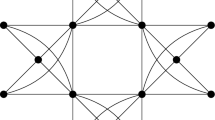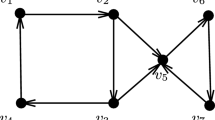Abstract
In this article, we consider the class of tress on a fixed number of vertices. We consider the problem of finding trees with first four minimum smallest positive eigenvalues. First we obtain the upper and lower bounds on number of alternating paths in a tree. It is shown that the smallest positive eigenvalue of a tree is related to the number of alternating paths in it. With the help of combinatorial arguments, the trees with the maximum, second maximum and third maximum number of alternating paths are derived. Subsequently, the unique trees with the second minimum, third minimum and fourth minimum smallest positive eigenvalue are characterized.





Similar content being viewed by others
References
Barik S, Neumann M, Pati S (2006) On nonsingular trees and a reciprocal eigenvalue property. Linear Multilinear Algebra 54:453–465
Buckley F, Doty LL, Harary F (1988) On graphs with signed inverses. Networks 18:151–157
Coulson CA, O’Leary B, Mallion RB (1978) Huckel theory for organic chemists. Academic Press, London
Cvetković D, Doob M, Sachs H (1980) Spectra of graphs-theory and applications. Academic Press, New York
Dias JR (1993) Molecular orbital calculations using chemical graph theory. Springer, Berlin
Frucht R, Harary F (1970) On the corona of two graphs. Aequ Math 4:322–325
Godsil CD (1985) Inverses of trees. Combinatorica 5(1):33–39
Graovac A, Gutman I (1980) Estimation of the HOMO–LUMO separation. Croat Chem Acta 53:45–50
Graovac A, Gutman I, Trinajstić N (1977) Topological approach to the chemistry of conjugated molecules. Springer, Berlin
Gutman I (1978) Total \(\pi \)-electron energy and molecular topology. Bibliography. MATCH Commun Math Comput Chem 4:195–200
Gutman I (1992) Total \(\pi \)-electron energy of benzenoid hydrocarbons. Top Curr Chem 162:29–63
Gutman I (2005) Topology and stability of conjugated hydrocarbons. The dependence of total \(\pi \)-electron energy on molecular topology. J Serb Chem Soc 70:441–456
Gutman I, Polansky OE (1986) Mathematical concepts in organic chemistry. Springer, Berlin
Gutman I, Rouvray D (1979) An approximate topological formula for the HOMO–LUMO separation in alternant hydrocarbons. Chem Phys Lett 62:384–388
Hall GG (1977) On the eigenvalues of molecular graphs. Mol Phys 33:551–557
Harary F (1969) Graph theory. Addison-Wesley Publishing Company, Boston
Hong Y (1989) Sharp lower bounds on the eigenvalues of trees. Linear Algebra Appl 113:101–105
Li X, Li Y, Shi Y, Gutman I (2013) Note on the HOMO–LUMO index of graphs. MATCH Commun Math Comput Chem 70:85–96
Pavlikova S, Krc-jediny J (1990) On the inverse and dual index of a tree. Linear Multilinear Algebra 28:93–109
Author information
Authors and Affiliations
Corresponding author
Additional information
Publisher's Note
Springer Nature remains neutral with regard to jurisdictional claims in published maps and institutional affiliations.
The first author acknowledges the financial support from CSIR, Government of India.
Rights and permissions
About this article
Cite this article
Rani, S., Barik, S. On alternating paths and the smallest positive eigenvalue of trees. J Comb Optim 39, 589–601 (2020). https://doi.org/10.1007/s10878-019-00503-0
Published:
Issue Date:
DOI: https://doi.org/10.1007/s10878-019-00503-0




